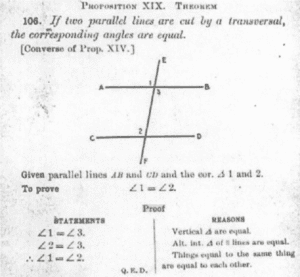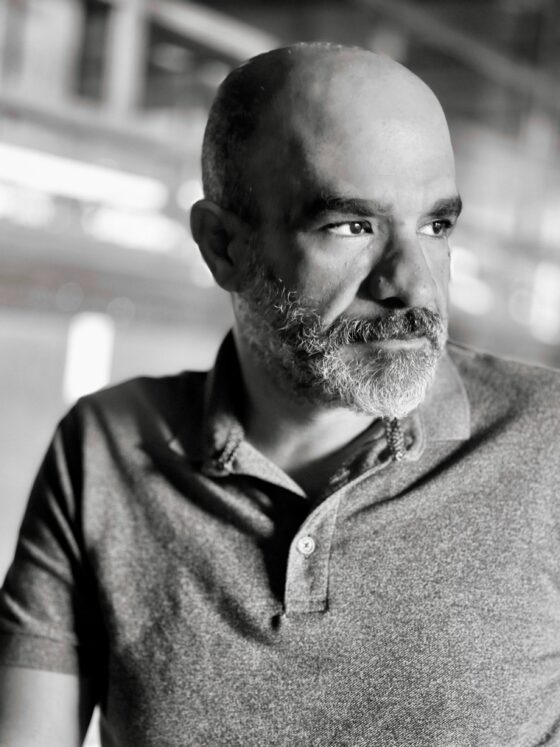
Mathematics is considered the model of black-and-white truth—the universal language of the world. But this is a myth.
I once taught Euclidean geometry, the most basic of all theoretical mathematics, to high school students. This geometry is based on a plane—a two-dimensional figure that stretches infinitely in two directions but has no thickness. Planes do not exist in real life, not really; neither do lines and points. A line has length but no width: one dimension. A point has neither length nor width: no dimensions. All plane figures—triangles, circles, angles, rays—are made up of these basic principles, lines and points. The study of Euclidean geometry is essentially faith in what cannot be seen. Euclidean geometry is also the foundation for the rules of engineering and physics. Therefore, it is a faith underpinning scientific facts.
I taught this faith to teenagers, who were actively working out their own understandings of truth and belief. Within the parameters of a plane, I asked them to prove statements of truth—that two angles have the same measure, for example, or that two lines are parallel—using only the definitions, postulates, and theorems of Euclidian geometry, not the tools of science—protractors, rulers, compasses. Our instrument was a two-column proof, the baby-step of mathematical analysis, in which a statement is paired with a fact that demonstrates the truth of that statement: Two angles are congruent because they are vertical angles, and two lines are parallel because a pair of internal angles on the same side of the transversal are supplementary.
My students complained about proving obvious truths, about listing what they considered superfluous steps. They asked why they couldn’t measure the angles to prove their congruence, and I explained that they were proving a larger reality. In Euclidean geometry, all such pairs of angles have the same measure. I confessed that abstract mathematics at their age was an exercise in critical thinking, and I modeled how to navigate the geography of truth. Like all mathematics, in Euclidian geometry, there is a set of given rules that makes the system work. Violate the rules, the agreed-upon facts, and everything falls apart.
Take this immutable fact: on a plane, parallel lines never meet. Each end of each line extends into infinity, always with the exact same distance between them. Put those parallel lines on a sphere, though, and they cross. The definition has changed, simply by changing the geography of the lines. Facts are not relative. Parallel lines on a plane do not intersect: that’s a fact. But the truth of the matter is incomplete until the lines are elsewhere.
Lately, it’s this malleability of truth that niggles the edge of my thoughts. News commentators scream about the importance of truth. More than one conservative thinker has said that the truth doesn’t really matter. When asked about President Trump’s unfounded claim of voter fraud, House Speaker Paul Ryan said, “It doesn’t matter. He won the election.” During the campaign, after several women came forward accusing Donald Trump of sexual assault, former Republican primary candidate Ben Carson said, “It doesn’t matter whether [his accusers] are lying or not.”
Conservatives claim that progressives miss the fact that Trump won. Meanwhile, progressives shout that the rotten core of Trump supporters is willfully ignorant to truth. Journalists wring their hands over fake news. Our President tweets “alternative facts.” We have debates about lies and alternate truths, as if we all agree that these are synonyms or antonyms, as if truth has always been a constant. Yet, mathematics—the most intellectual of all pursuits, the midwife of philosophy and science—demonstrates the fallacy of this thinking.
Take job numbers, for example. The country’s unemployment rate dropped from 9.80 percent in 2010 to 4.70 in 2016, as reported by the US Bureau of Labor Statistics. To most economists and many progressives, this is a huge feat. To those who live in Cheboygan County, Michigan (just at the middle finger of the “mitten”), their 14.2 percent unemployment rate belies this truth. Both are facts, but it’s the geography that ultimately defines the truth of the matter. Using one number to describe the experience of the entire country erases the smaller subsets, individual experiences.
In our own bubbles, we pick and choose the facts that reflect our realities. But a scientific reality can help us see this in a new light: When two same-size soap bubbles collide, they merge, sharing one wall to minimize surface area. If one of the bubbles is smaller, it punches into the larger bubble. Could the same be true for us?
I grew up in the mountains of Southwest Virginia, part of the Appalachian region of the country—a place that is often ignored unless politically expedient. I wasn’t born there; my parents chose the Blue Ridge when I was four years old, having fallen in love with the tight-knit community that prides itself in simplicity and turtle-like progress. I left for college at eighteen and for good at twenty-two, having learned another truth of the place: I was and will continue to be an outsider, damned to suspicion and distrust. I accepted my place and learned to watch from the edges, longing for a way in. Some of my immediate family still lives there, and though I have technically become a Northerner, my heart skips a beat at the sight of the Blue Ridge Mountains. I nearly married a man whose family was rooted there, just at the base of Walker Mountain, but I left the county as soon as I was able, choosing rush-hour traffic over wide fields. He’s much better off without me, and I’m much better off living in Baltimore with my wife and our daughter. The facts are simple: he is straight and I am queer. The truth is much more complex: we truly loved one other way back when.
Social media has helped me reconnect with high school friends and acquaintances from back home. We share photographs of our kids and memes that tell each other who we are today. Sometimes we share opposing truths that reveal our vulnerabilities and fears and faith.
Sometime in the last eighteen months, I hid the posts on Facebook of one hometown friend, because she favorited memes that painted Hillary a liar and Trump a savior. The untruths expressed were offensive to my urban and journalistic sensibility, but somehow Trump’s language echoed the pain she was feeling as a chronically ill, lesbian Volvo-plant worker with a union card and two master’s degrees. She posted false statistics on race and murder and incorrect information about immigrants and crime. I search for her hidden posts from time to time, just to see if her perspective has changed, as Trump’s rhetoric and crowds got meaner, as he took the oath of office. It didn’t. His truth spoke to hers, even when I could smack down the facts she lobbed lazily over the net that divides us.
More than once, I have attempted to reason with her. I have shared statistics and quotes. I have asked her genuine questions, and she has genuinely responded. She and I have far more in common than not, I believe. And she offers me a simple statement of her truth: “You have your opinion, and I have mine.” It makes no difference that the facts conflict. It’s the geography of her truth—the plane, the sphere, the Appalachian Mountains, the Baltimore streets—that matters in this exchange. No two-column proof could correct her misunderstanding or mine.
We have remained connected through social media, despite these conversations. She’s fine with our differences, while the disparities shake something vital inside me, something foundational that I cannot shrug off. In my hometown, differences of opinion—differences of truth—are accepted and natural. You go your way and I’ll go mine. We’ll catch up online or in line at the Walmart. Instinctive acceptance is as natural as breathing in those mountains. There is acceptance of the weather, of disease, and hard times because that’s what it means to be human and because it’s God’s will anyway. There is acceptance of industry—coal companies rolling over their workers, industrial plants laying off employees, milk prices going up or down because of some abstract notion of supply and demand.
My truth is not the truth of those who can trace their lineage back to the 1700s in those mountains. This has nothing to do with facts. Truth is perspective—a plane or a sphere—which makes it feel slippery. Truth is not absolute in the ways that we want it to be.
In college abstract algebra classes, students consider the properties of algebra in an utterly theoretical sense, categorizing mathematical concepts, like addition and multiplication, based on how they affect the original set of elements, like positive whole numbers. The course is high school geometry on steroids, a game-changer for most math majors, who are used to computation rather than esoteric ideas. Essentially abstract algebra is walking deeper into the woods of critical thinking. The class depends on independent, logical thinking. There are different paths to ultimate truths, and facts will often point to varying truths.
The foundational element of abstract algebra is the group, which is best described with an example: Addition over the set of positive and negative whole numbers (integers) is a group, because the set meets four properties. The set is closed, because when you add two integers, you get an integer. In other words, 1 + 3 = 4, and 1, 3, and 4 are positive whole numbers. The set is associative, because you can add in any order: (1 + 2) + 3 = 1 + (2 + 3) = 6. The set has an identity, specifically 0; when you add 0 to any integer, you get the original integer. And finally, each element of the set has an inverse: 1 + -1 = 0, so -1 is the inverse of 1 and 1 is the inverse of -1. However, subsets of integers with addition are not necessarily groups. For example, the set {1, -1} over addition is not a group, because it is not closed (1 + -1 = 0, and 0 is not in the group) and it has no identity (0 + 1 = 1, but again, 0 is not in the group. This doesn’t mean that 1 + -1 ≠ 0—that’s an immutable fact. But these two numbers themselves do not form a group.
This is all very heady stuff indeed, interesting only to the most dedicated of mathematicians or puzzle solvers. Still, it speaks to truth in a way that we may have forgotten. Defining the category—the group—is essential to truth. Facts cannot be argued, but truth is pliant. Geography reveals the relationships between facts and truth.
For the last two weeks, I have been sitting in on an abstract algebra course at a local university. I’m not doing homework or taking tests; I don’t want to be proficient in the mathematics. To be honest, I can barely parse the notation, which I’ve forgotten, much less the professor’s Chinese accent, which is thick. I first took the course nearly thirty years ago as an undergraduate, and I remember that it blew my mind. For three decades, my thoughts have not strayed far from the structure of mathematics, the elegance of our number systems, and the beauty of the properties that dictate arithmetic and algebra. There’s something Zen-like in the mysteries tucked within certainties. And ultimately it’s a truth based on assumed or provable facts that beckons. In this uncertain time, I want to feel the instability of our most reliable science, catching glimpses of the absolute within the chalk dust.
For as much as we want our world—and the mathematics that defines it—to be circumscribed by one truth, reality begs to differ.
***
Image credit: Creative Commons by Pearson Scott Foresman.





